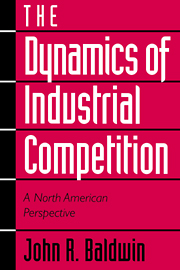Book contents
- Frontmatter
- Contents
- preface
- Acknowledgements
- 1 The dynamics of competition
- 2 Greenfield entry and closedown exit
- 3 Entry, exit, and the merger process
- 4 The rise and fall of incumbents
- 5 Patterns of large- and small-firm mobility
- 6 Plant turnover in Canada and the United States
- 7 Measures of market structure and the intensity of competition
- 8 The relationship between mobility and concentration
- 9 Turnover and productivity growth
- 10 Merger success
- 11 Turnover in domestic and foreign enterprises
- 12 Industry efficiency and firm turnover in the Canadian manufacturing sector
- 13 Firm turnover and profitability
- 14 Modelling entry
- 15 Conclusion
- Appendix A Measuring firm turnover – methodology
- Appendix B Definition of concentration and mobility measures
- Notes
- References
- Author index
- Subject index
3 - Entry, exit, and the merger process
Published online by Cambridge University Press: 30 March 2010
- Frontmatter
- Contents
- preface
- Acknowledgements
- 1 The dynamics of competition
- 2 Greenfield entry and closedown exit
- 3 Entry, exit, and the merger process
- 4 The rise and fall of incumbents
- 5 Patterns of large- and small-firm mobility
- 6 Plant turnover in Canada and the United States
- 7 Measures of market structure and the intensity of competition
- 8 The relationship between mobility and concentration
- 9 Turnover and productivity growth
- 10 Merger success
- 11 Turnover in domestic and foreign enterprises
- 12 Industry efficiency and firm turnover in the Canadian manufacturing sector
- 13 Firm turnover and profitability
- 14 Modelling entry
- 15 Conclusion
- Appendix A Measuring firm turnover – methodology
- Appendix B Definition of concentration and mobility measures
- Notes
- References
- Author index
- Subject index
Summary
Introduction Different processes contribute to the dynamics of intra-industry growth and decline. Firm turnover transfers resources from one group to another. The emergence of new firms causes some firms to exit and others to decline.
Greenfield entry and closedown exit is the process that changes the firm population in the most obvious way. When a firm enters by building new plant or when it leaves by closing plant, the effect on jobs and productive capacity is immediate.
Resources are also transferred as a result of ownership-control changes. Control is shifted from one group of owners to another in a variety of ways. One firm may purchase all of the shares or assets of another and subsume the acquired operations into its own; or it may maintain them as entirely separate entities. Control can also be shifted when only a controlling interest is acquired. In this case, control of the firm has changed hands, although the firm has not been entirely acquired.
Changes in control are often, though not invariably, associated with a merging of the interests of two companies. Control can be shifted without such a merging of two firms' interests – for example, when different factions of shareholders, who do not represent other firms' interests, rearrange the majority coalition that controls the company. But this situation is not common in this database. Thus, for all intents and purposes, changes in control that are examined here are those accomplished by mergers and acquisitions of some type.
It is ironic that greenfield entry and closedown exit, whose short-run impact is readily apparent, have received little attention. Mergers, on the other hand, have been the focus of many studies.
- Type
- Chapter
- Information
- The Dynamics of Industrial CompetitionA North American Perspective, pp. 30 - 60Publisher: Cambridge University PressPrint publication year: 1995



